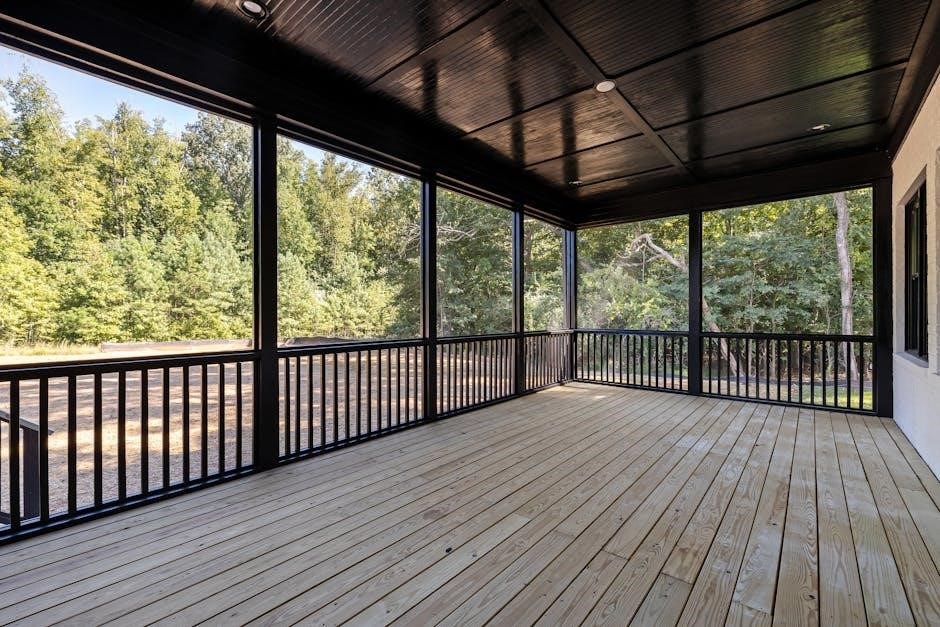Prescriptive residential deck construction guides provide essential standards for safe and durable decks‚ focusing on IRC compliance‚ structural integrity‚ and adherence to local building codes and best practices.
1.1 Understanding the Importance of Prescriptive Guides
Prescriptive guides are essential for ensuring deck safety and durability by providing standardized methods and materials that meet or exceed building codes. These guides simplify construction by offering clear‚ step-by-step instructions and tables for spans‚ sizes‚ and spacing of structural components. Compliance with prescriptive guidelines ensures adherence to local regulations and reduces the risk of structural failures. By following these guidelines‚ builders can avoid costly mistakes and create decks that are both functional and safe for years to come.
1.2 Overview of the International Residential Code (IRC)
The International Residential Code (IRC) provides comprehensive guidelines for deck construction‚ ensuring safety and structural integrity. It includes detailed tables for joist and beam spans‚ load calculations‚ and specific requirements for ledger boards‚ posts‚ and footings. The IRC serves as a foundational reference for prescriptive construction methods‚ outlining minimum standards for materials and installation. Compliance with the IRC ensures decks meet local building codes and industry best practices‚ reducing risks and ensuring durability.

Key Components of Deck Construction
Deck construction involves critical components like joists‚ beams‚ ledger boards‚ posts‚ footings‚ and railings‚ each playing a vital role in ensuring safety‚ stability‚ and structural integrity.
2.1 Joists and Beams: Size‚ Spacing‚ and Span Tables
Joists and beams are fundamental to deck structural integrity. The IRC provides span tables to determine maximum joist spans based on lumber size and spacing. These tables help ensure safe loading capacity and prevent excessive deflection. Proper sizing and spacing are critical to meet load-bearing requirements. Cantilevers‚ where joists extend beyond beams‚ must also comply with IRC guidelines. Figure 1 outlines typical joist span configurations‚ ensuring decks are both durable and secure. Adhering to these specifications is essential for a structurally sound and long-lasting deck.
2.2 Ledger Board: Installation and Requirements
The ledger board is a critical structural component attached to the house‚ supporting the deck. IRC requires it to be at least 38×184 mm‚ securely fastened with lag screws or through-bolts. Proper flashing installation is essential to prevent water damage. Local codes may add specific requirements‚ ensuring safety and durability. Correct installation ensures the deck remains stable and secure‚ adhering to prescriptive guidelines for long-term performance and safety.
2.3 Posts and Footings: Load-Bearing Capacity and Depth
Posts and footings are essential for transferring deck loads to the ground. IRC specifies minimum post sizes and footing depths to ensure stability. Footings must extend below frost depth to prevent shifting. Proper sizing ensures the structure can handle weight safely.
Load calculations guide post and footing dimensions. Concrete footings with reinforcing steel enhance durability. Local building codes may require additional inspections or specific construction methods.
2.4 Railings and Guards: Height and Structural Integrity
Railings and guards are critical for deck safety‚ with IRC specifying minimum heights and structural requirements. Railings typically range from 36 to 42 inches tall‚ ensuring visibility and user safety. Guards‚ often required on decks over 30 inches high‚ must be sturdy to prevent collapse. Proper material selection and installation are vital for load-bearing capacity. Regular inspections are recommended to maintain integrity and ensure compliance with local building codes.
Local Building Codes and Permits
Local building codes and permits ensure compliance with safety standards‚ varying by jurisdiction but often based on IRC guidelines. Permits are required for deck construction to verify structural integrity and adherence to regulations.
3.1 Understanding Local Regulations and Variations
Local building codes often align with the IRC but may include additional requirements based on regional factors like climate‚ soil conditions‚ or local ordinances. Deck construction must comply with these specific regulations‚ which can vary significantly between jurisdictions. Key areas of variation include joist spans‚ guardrail heights‚ and footing depths. Understanding these local adaptations is crucial for ensuring compliance and safety. Deck builders should always consult their local building authority to confirm requirements before starting a project‚ as failure to comply can result in costly modifications or permit rejection.
3.2 Obtaining Necessary Permits for Deck Construction
Obtaining the required permits is a critical step in deck construction to ensure compliance with local building codes and safety standards. Homeowners must submit detailed plans‚ including a framing layout and materials list‚ for approval. Zoning and building permits are typically necessary‚ and inspections may be conducted during and after construction. Failure to secure permits can result in legal issues‚ fines‚ or even the removal of the deck. Always verify permit requirements with local authorities to avoid delays and ensure a smooth construction process.

Safety Considerations and Best Practices
Safety is paramount in deck construction‚ focusing on preventing common hazards like structural failures and trip hazards. Proper fasteners and regular inspections ensure durability and compliance with IRC standards.
4.1 Common Hazards and Prevention Measures
Common deck hazards include structural failures‚ rot‚ and decay‚ often due to improper construction or maintenance. To prevent these‚ ensure proper ledger board attachment using lag screws‚ and use pressure-treated lumber for components in contact with the ground. Regularly inspect for rot‚ loose connections‚ and wear on decking boards. Railings and guards must meet height standards (typically 36 inches) and include intermediate rails to prevent accidents. Annual inspections and addressing issues promptly are key to ensuring long-term safety and durability.
- Use treated lumber for ground-contact components.
- Ensure railings meet height and structural standards.
- Inspect annually for rot‚ looseness‚ or wear.
4.2 Proper Fasteners and Connections for Durability
Proper fasteners and connections are critical for ensuring deck durability and safety. Use galvanized or stainless steel nails‚ screws‚ or bolts to resist corrosion and maintain structural integrity. Ledger boards should be secured with lag screws or through-bolts‚ while joist hangers and post anchors provide additional stability. Tight connections between beams‚ joists‚ and posts are essential to prevent shifting or collapse. Always follow manufacturer recommendations for fastener types and spacing to ensure compliance with IRC standards and long-term performance.
- Use galvanized or stainless steel fasteners for corrosion resistance.
- Secure ledger boards with lag screws or through-bolts.
- Ensure tight‚ stable connections between all structural components.
Framing and Structural Layout
A framing plan outlines the joist and beam layout‚ ensuring proper spacing and alignment. Ledger boards‚ posts‚ and footings are strategically located for optimal structural support and stability.
5.1 Creating a Framing Plan: Joist and Beam Layout
A framing plan is essential for ensuring structural integrity. Joists and beams must be properly sized and spaced according to IRC span tables to support deck loads. The layout should align with the ledger board‚ posts‚ and footings‚ ensuring even distribution of weight. Proper spacing and alignment prevent sagging and ensure safety. Using span tables helps determine maximum joist spans based on lumber size and spacing. A well-designed framing plan ensures compliance with building codes and provides a sturdy foundation for the deck.
5.2 Location and Spacing of Ledger Board‚ Posts‚ and Footings
Proper placement and spacing of the ledger board‚ posts‚ and footings are critical for structural integrity. The ledger board must be securely attached to the house‚ while posts and footings should be spaced according to load-bearing requirements. IRC guidelines dictate minimum depths and spacing to ensure stability. Improper placement can lead to safety hazards‚ so precise planning is essential. A well-designed layout ensures compliance with building codes and supports the deck’s structural demands effectively;

Materials and Fasteners
Selecting the right lumber and fasteners ensures durability and safety. The IRC recommends specific materials for load-bearing components‚ while proper fasteners prevent rot and structural weakening over time.
6.1 Choosing the Right Lumber for Deck Construction
Choosing the right lumber ensures durability and safety. Pressure-treated lumber is ideal for posts and joists exposed to moisture‚ while naturally rot-resistant woods like cedar or redwood are great for decking. The IRC specifies minimum standards for lumber sizes and grades to ensure structural integrity. Always verify the load-bearing capacity of the lumber and refer to span tables for appropriate sizing. Proper material selection prevents warping‚ rot‚ and structural failure‚ ensuring a sturdy and long-lasting deck that meets local building codes and safety standards.
6.2 Fasteners: Nails‚ Screws‚ and Bolts for Structural Integrity
Fasteners are critical for ensuring the structural integrity of a deck. Galvanized or stainless steel nails and screws are recommended to resist corrosion. Use screws for decking boards to provide a secure‚ tight connection. Bolts are essential for heavy-duty connections‚ such as beam-to-post joints. Always follow IRC guidelines for fastener types‚ sizes‚ and spacing. Proper fastening ensures load-bearing capacity and prevents structural failure. Avoid over-tightening to prevent splitting wood. Using the right fasteners enhances safety‚ durability‚ and compliance with building codes‚ ensuring a sturdy and reliable deck structure.

Deck Maintenance and Inspection
Regular inspections and maintenance are crucial for ensuring deck safety and longevity. Check for rot‚ insect damage‚ and loose fasteners‚ addressing issues promptly to prevent structural decay.
7.1 Regular Inspections for Safety and Durability
Regular inspections are vital to ensure deck safety and durability. Homeowners should check for rot‚ insect damage‚ and loose fasteners‚ addressing issues promptly to prevent structural decay.
Inspect joists‚ beams‚ and connections annually‚ especially in areas exposed to moisture. Look for signs of wear‚ such as cracks or sagging‚ and ensure all components meet IRC standards for stability and strength.
7.2 Maintenance Tips to Extend Deck Lifespan
Regular maintenance is key to extending the life of your deck. Clean debris from between boards and under the deck to prevent rot and pest infestations. Apply a waterproof sealant or stain annually to protect wood from moisture damage. Tighten loose fasteners and replace any corroded or damaged hardware. Inspect and replace worn-out boards promptly. Keep the deck area clear of leaves and dirt to avoid mildew growth. Proper care ensures your deck remains safe‚ durable‚ and visually appealing for years to come.

case Studies and Real-World Examples

Case Studies and Real-World Examples
Explore successful deck construction projects and lessons learned from common mistakes. Real-world examples provide practical insights into designing durable‚ code-compliant decks that enhance outdoor living spaces.
8.1 Successful Deck Construction Projects
Successful deck projects highlight adherence to IRC guidelines‚ innovative design‚ and quality materials. A multi-level deck in Colorado‚ built with pressure-treated lumber‚ exemplifies proper joist spacing and beam support. Another project in Florida features a floating deck with reinforced footings‚ ensuring stability in sandy soil. These examples demonstrate how prescriptive methods ensure safety and durability while enhancing outdoor living spaces. They also illustrate the importance of local code compliance and proper inspections for long-term structural integrity.
8.2 Lessons Learned from Common Mistakes
Common deck construction mistakes include improper joist spacing‚ inadequate footings‚ and ledger board installation errors. Many issues arise from ignoring IRC guidelines or using incorrect fasteners. For example‚ neglecting to secure the ledger board properly can lead to structural failure. Additionally‚ failing to ensure guardrails meet height requirements compromises safety. These oversights highlight the importance of adhering to prescriptive standards and conducting thorough inspections. Learning from these mistakes ensures safer‚ more durable decks and avoids costly repairs down the line.

No Responses